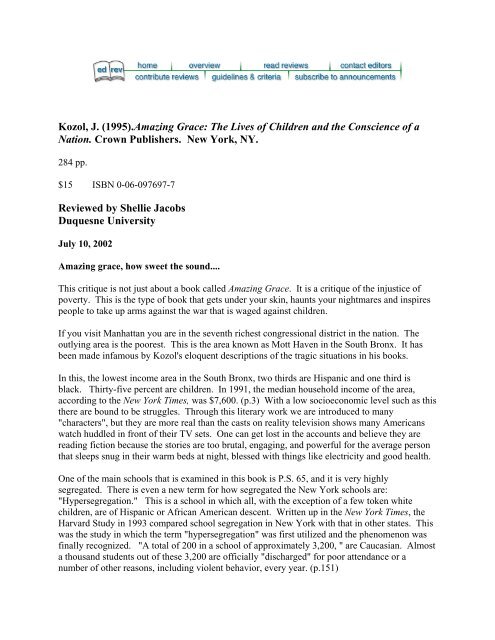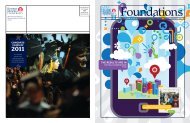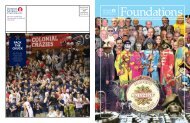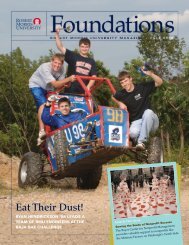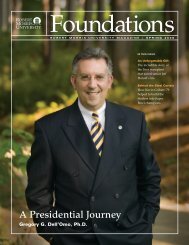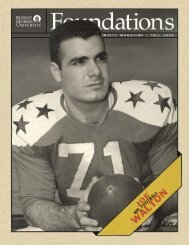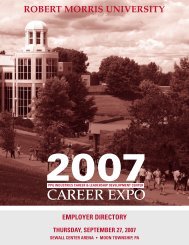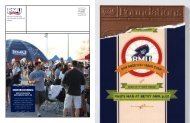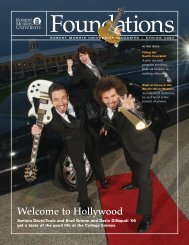Kozol, J. (1995).Amazing Grace: The Lives of Children and the ...
Kozol, J. (1995).Amazing Grace: The Lives of Children and the ...
Kozol, J. (1995).Amazing Grace: The Lives of Children and the ...
You also want an ePaper? Increase the reach of your titles
YUMPU automatically turns print PDFs into web optimized ePapers that Google loves.
<strong>Kozol</strong>, J. (<strong>1995</strong>).<strong>Amazing</strong> <strong>Grace</strong>: <strong>The</strong> <strong>Lives</strong> <strong>of</strong> <strong>Children</strong> <strong>and</strong> <strong>the</strong> Conscience <strong>of</strong> aNation. Crown Publishers. New York, NY.284 pp.$15 ISBN 0-06-097697-7Reviewed by Shellie JacobsDuquesne UniversityJuly 10, 2002<strong>Amazing</strong> grace, how sweet <strong>the</strong> sound....This critique is not just about a book called <strong>Amazing</strong> <strong>Grace</strong>. It is a critique <strong>of</strong> <strong>the</strong> injustice <strong>of</strong>poverty. This is <strong>the</strong> type <strong>of</strong> book that gets under your skin, haunts your nightmares <strong>and</strong> inspirespeople to take up arms against <strong>the</strong> war that is waged against children.If you visit Manhattan you are in <strong>the</strong> seventh richest congressional district in <strong>the</strong> nation. <strong>The</strong>outlying area is <strong>the</strong> poorest. This is <strong>the</strong> area known as Mott Haven in <strong>the</strong> South Bronx. It hasbeen made infamous by <strong>Kozol</strong>'s eloquent descriptions <strong>of</strong> <strong>the</strong> tragic situations in his books.In this, <strong>the</strong> lowest income area in <strong>the</strong> South Bronx, two thirds are Hispanic <strong>and</strong> one third isblack. Thirty-five percent are children. In 1991, <strong>the</strong> median household income <strong>of</strong> <strong>the</strong> area,according to <strong>the</strong> New York Times, was $7,600. (p.3) With a low socioeconomic level such as this<strong>the</strong>re are bound to be struggles. Through this literary work we are introduced to many"characters", but <strong>the</strong>y are more real than <strong>the</strong> casts on reality television shows many Americanswatch huddled in front <strong>of</strong> <strong>the</strong>ir TV sets. One can get lost in <strong>the</strong> accounts <strong>and</strong> believe <strong>the</strong>y arereading fiction because <strong>the</strong> stories are too brutal, engaging, <strong>and</strong> powerful for <strong>the</strong> average personthat sleeps snug in <strong>the</strong>ir warm beds at night, blessed with things like electricity <strong>and</strong> good health.One <strong>of</strong> <strong>the</strong> main schools that is examined in this book is P.S. 65, <strong>and</strong> it is very highlysegregated. <strong>The</strong>re is even a new term for how segregated <strong>the</strong> New York schools are:"Hypersegregation." This is a school in which all, with <strong>the</strong> exception <strong>of</strong> a few token whitechildren, are <strong>of</strong> Hispanic or African American descent. Written up in <strong>the</strong> New York Times, <strong>the</strong>Harvard Study in 1993 compared school segregation in New York with that in o<strong>the</strong>r states. Thiswas <strong>the</strong> study in which <strong>the</strong> term "hypersegregation" was first utilized <strong>and</strong> <strong>the</strong> phenomenon wasfinally recognized. "A total <strong>of</strong> 200 in a school <strong>of</strong> approximately 3,200, " are Caucasian. Almosta thous<strong>and</strong> students out <strong>of</strong> <strong>the</strong>se 3,200 are <strong>of</strong>ficially "discharged" for poor attendance or anumber <strong>of</strong> o<strong>the</strong>r reasons, including violent behavior, every year. (p.151)
On <strong>the</strong> average school day instead <strong>of</strong> just pledging allegiance to <strong>the</strong> flag <strong>and</strong> going over <strong>the</strong>school roll, <strong>the</strong>y have a slightly unusual morning routine. <strong>The</strong> teacher coaches <strong>the</strong>m by askingwhat <strong>the</strong> holes are in <strong>the</strong> window <strong>and</strong> <strong>the</strong> students reply in unison, "bullet-holes." <strong>The</strong>y <strong>the</strong>n goover a drill, very similar to a tornado drill, where <strong>the</strong>y practice getting down if <strong>the</strong>y heargunshots. According to Maslow's Hierarchy <strong>of</strong> Needs, students have certain needs that must bemet before <strong>the</strong>y are able to learn in a school environment. How do children learn when <strong>the</strong>y arelistening to <strong>the</strong> sound <strong>of</strong> <strong>the</strong>ir empty bellies rumbling <strong>and</strong> listening to hear a bullet shot before itleaves <strong>the</strong> gun? How can we dem<strong>and</strong> high test scores <strong>and</strong> work completed correctly when <strong>the</strong>personal hunger <strong>and</strong> safety needs <strong>of</strong> <strong>the</strong> students continue to be unmet even in <strong>the</strong> classroom?According to <strong>the</strong> principal, <strong>the</strong>re are many students who bring to <strong>the</strong> school physical evidence <strong>of</strong>pain <strong>and</strong> hardship. Some wear <strong>the</strong>ir pain in <strong>the</strong> form <strong>of</strong> <strong>the</strong> inhalers that almost every childcarries for asthma <strong>and</strong> some with burns from fires in <strong>the</strong>ir neighborhoods. He explained, "Some<strong>of</strong> our children have been horribly disfigured in fires. I notice, though, that <strong>the</strong> o<strong>the</strong>r childrentreat <strong>the</strong>m kindly <strong>and</strong> not make fun <strong>of</strong> <strong>the</strong>m. <strong>The</strong>re is a protective feeling that can beextraordinarily moving. <strong>The</strong>re is nothing predatory in <strong>the</strong>se children. <strong>The</strong>y know that <strong>the</strong> worlddoes not much care for <strong>the</strong>m <strong>and</strong> <strong>the</strong>y try hard to be <strong>the</strong>re for each o<strong>the</strong>r." (p. 64)Self-efficacy is not high in this school <strong>and</strong> it becomes apparent when you hear <strong>the</strong> voices <strong>of</strong> <strong>the</strong>children in this book. <strong>The</strong>y see how o<strong>the</strong>rs view <strong>the</strong>ir environment. <strong>The</strong> self-esteem <strong>of</strong> childrenhas been crushed to <strong>the</strong> degree that students ridicule <strong>the</strong>mselves, as David Washington toldJonathan, by making a bitter joke out <strong>of</strong> <strong>the</strong> letters <strong>of</strong> <strong>the</strong> school's name. "'Taft,'" <strong>the</strong>y say means"Training Animals For Tomorrow." (p.152) <strong>The</strong> students see that <strong>the</strong>y do not get an equaleducation compared to o<strong>the</strong>r students in <strong>the</strong> city. <strong>The</strong>se are not students who are unintelligent;<strong>the</strong>y were simply dealt a bad h<strong>and</strong>. <strong>The</strong> question that one wants to ask is: What do o<strong>the</strong>r kidsdeserve <strong>and</strong> how is <strong>the</strong> whole idea <strong>of</strong> a "deserving" or an "undeserving" person used to masksome <strong>of</strong> <strong>the</strong> cumulative consequences <strong>of</strong> injustice? (p.154)<strong>The</strong>re are children who do not have bedrooms; but one adolescent named Anthony who sticksout in this book as one <strong>of</strong> <strong>the</strong> hopes <strong>of</strong> Mott Haven explains that he is not ambitious for abedroom. He explains that he is "ambitious for more books." Luckily, towards <strong>the</strong> end <strong>of</strong> <strong>the</strong>book we learn that this insightful young man just may get a chance to broaden his horizonsbecause he will be going to Jerusalem with <strong>the</strong> pastor from his church. Upon reading this, <strong>the</strong>readers find <strong>the</strong>mselves cheering inside. We want <strong>the</strong>se children to get out <strong>of</strong> this situation, torise above <strong>the</strong> poverty that is drowning <strong>the</strong>m. Ano<strong>the</strong>r young man that could sing his sweet song<strong>of</strong> freedom from <strong>the</strong> poverty is named David. In <strong>the</strong> book his gr<strong>and</strong>mo<strong>the</strong>r explains that he hasjust been accepted to City University with full financial assistance. David's gr<strong>and</strong>mo<strong>the</strong>rexplains her feelings about this fantastic news to Jonathan: "I'm happy," she says, smilingthrough her tears, <strong>and</strong> she keeps saying it, "I'm happy. Something good has happened,something GOOD! No one can take that from him now." (p. 236) It is <strong>the</strong> first time that <strong>Kozol</strong>saw her cry that way, without embarrassment, without constraint, without trying to conceal,because <strong>the</strong>y were tears <strong>of</strong> hope for this generation.That saved a wretch like me....
"Nearly 4,000 heroin injectors, many <strong>of</strong> whom are HIV infected, live here. Virtually every childat St. Ann's knows someone, a relative or neighbor, who has died <strong>of</strong> AIDS, <strong>and</strong> most childrenhere know many o<strong>the</strong>rs who are now dying <strong>of</strong> <strong>the</strong> disease." (p. 4) <strong>The</strong>se burdens are seen on <strong>the</strong>faces <strong>of</strong> <strong>the</strong> children <strong>and</strong> in <strong>the</strong> stories that <strong>the</strong> adults tell about <strong>the</strong> horror <strong>of</strong> living in this type <strong>of</strong>disease-ridden environment. It affects <strong>the</strong> culturally diverse community deeply. In this city 9out <strong>of</strong> 10 children who are born with AIDS are black or Latinos. (p.174) AIDS creeps into <strong>the</strong>live <strong>of</strong> both unsuspecting drug users <strong>and</strong> <strong>the</strong> quiet babies in <strong>the</strong> wombs <strong>of</strong> <strong>the</strong>ir mo<strong>the</strong>rs. <strong>The</strong>incubation period for <strong>the</strong> development <strong>of</strong> AIDS in infants is, generally, shorter than for adults. Itis on average three years but most die in 18 months. Only 5% live to be twelve years old. (p.195) <strong>The</strong>se lives <strong>and</strong> <strong>the</strong> dreams <strong>the</strong>y could have fulfilled are lost. Those babies will never growto be <strong>the</strong> Anthony who goes to Jerusalem or <strong>the</strong> David who gets accepted into <strong>the</strong> college.<strong>The</strong> parents too are leaving this earth due to this virus. By <strong>the</strong> spring <strong>of</strong> 1993, 1,381 women <strong>and</strong>3,428 <strong>and</strong> men in <strong>the</strong> South Bronx had been diagnosed with AIDS. (p.194) According to <strong>the</strong>creator <strong>of</strong> <strong>the</strong> Orphans Project for those children that are left alone due to <strong>the</strong> tragedy <strong>of</strong> AIDS,"Only <strong>the</strong> great influenza p<strong>and</strong>emic <strong>of</strong> 1918 ... <strong>of</strong>fers a partial analogy from diseases <strong>of</strong> <strong>the</strong>twentieth century.... We are only <strong>the</strong> beginning <strong>of</strong> this phenomenon. We do not yet know <strong>the</strong>outcome." <strong>The</strong> Times refers to this section <strong>of</strong> New York as <strong>the</strong> "<strong>the</strong> deadliest blocks" in <strong>the</strong>"deadliest precinct" <strong>of</strong> <strong>the</strong> city. (p.5)<strong>The</strong>n <strong>the</strong>re are <strong>the</strong> children <strong>and</strong> parents who do survive a life <strong>of</strong> poverty surrounded by drugs <strong>and</strong>AIDS. It is recognized that many children in poor neighborhoods such as Mott Haven have beenneurologically impaired, some because <strong>of</strong> low weight at birth, some because <strong>of</strong> drug ingestionwhile in utero, <strong>and</strong> many from lead poisoning in <strong>the</strong>ir homes <strong>and</strong> also, shockingly enough, within<strong>the</strong>ir schools. (p.155) <strong>The</strong> lead paint that is used in <strong>the</strong> schools is <strong>of</strong>ten old <strong>and</strong> cracked <strong>and</strong> notmaintained, <strong>and</strong> once again even <strong>the</strong> schools become unsafe, not <strong>the</strong> havens that <strong>the</strong>se childrendeserve as American citizens."Why do you want to put so many people with small children in a place with so much sickness?This is <strong>the</strong> last place in New York that <strong>the</strong>y should put poor children. Clumping so many people,all with <strong>the</strong> same symptoms <strong>and</strong> same problems, in one crowded place with nothing <strong>the</strong>y cangrow on? Our children start to mourn <strong>the</strong>mselves before <strong>the</strong>ir time." (p. 11) In all <strong>of</strong> thissickness, <strong>the</strong> ratio <strong>of</strong> doctors to patients in <strong>the</strong> area is 30 times less than in Manhattan.Where are <strong>the</strong> mentors, heroes <strong>and</strong> leaders in this community? All you need to do is lookaround <strong>and</strong> see who has <strong>the</strong> flashiest car, <strong>the</strong> gold chains, <strong>the</strong> snazzy suit, <strong>and</strong> who has <strong>the</strong> abilityto throw thous<strong>and</strong>s <strong>of</strong> dollars into <strong>the</strong> street. In Mott Haven, this man's name was GeorgeCaldron. "He'd been a heroin user himself since he was ten years old," explained a woman whendescribing <strong>the</strong> local drug lord. "By 1986 or '87 he was renting certain corners to <strong>the</strong> lower-leveldealers for $200,000 yearly." This was a man who got o<strong>the</strong>rs addicted <strong>and</strong> brought down <strong>the</strong>neighborhood but he was a hero to some <strong>of</strong> <strong>the</strong> once wide-eyed inquisitive children that hadpotential, that stuck a needle in <strong>the</strong>ir veins with dreams <strong>of</strong> wiping away <strong>the</strong> pain <strong>of</strong> poverty.However, <strong>the</strong> poet Mr. Castro explained, "when he died, he was deeply mourned. His funeralwas well attended. <strong>The</strong> great hero <strong>of</strong> Paradise Lost, <strong>of</strong> course, was Satan. He is much moreinteresting than <strong>the</strong> angels."
<strong>The</strong>re are o<strong>the</strong>r heroes in this neighborhood. Some are <strong>the</strong> mo<strong>the</strong>rs who, like angels, oversee <strong>the</strong>community. <strong>The</strong>ir tales are as harrowing as a ten-year-old drug user. "I think <strong>of</strong> a woman,Charlotte Smith, who this morning buried her fourth child but remains a fighter, upright <strong>and</strong>unbroken. But good Lord! <strong>The</strong> miseries around her are so vast." (p. 72)I hear on <strong>the</strong> sidewalks people sneering at <strong>the</strong> homeless <strong>and</strong> casually saying, "Get a job." Butwhat if like in Mott Haven, <strong>the</strong>re simply are not enough jobs? "<strong>The</strong> greatest need in <strong>the</strong>neighborhood is real employment. Some <strong>of</strong> <strong>the</strong> men come in here <strong>and</strong> <strong>the</strong>y want a job so bad.You see it in <strong>the</strong>ir eyes. <strong>The</strong>y ask. <strong>The</strong>y question me continually. I have to tell <strong>the</strong>m honestlythat <strong>the</strong>re is nothing her," explains <strong>the</strong> security director <strong>of</strong> a complex. (p. 62)I once was lost....Lost on <strong>the</strong> sea <strong>of</strong> poverty without a paddle to steer <strong>the</strong>m to safety, Anthony tries to examinewhy we are here <strong>and</strong> why his peers can't move in <strong>the</strong> right direction with <strong>the</strong>ir lives. "I believethat we were put here for a purpose, but <strong>the</strong>se people on <strong>the</strong> streets can't see a purpose. <strong>The</strong>re's awhole world out <strong>the</strong>re if you know it's <strong>the</strong>re, if you can see it. But <strong>the</strong>y are in a cage. <strong>The</strong>y cannot see." (p. 24) When you can't see past <strong>the</strong> storm because you know that you can't even findyour compass, you can feel very trapped, indeed.<strong>The</strong> power <strong>of</strong> Anthony's insights hits home because <strong>of</strong> <strong>the</strong> simple way that he states <strong>the</strong> truth <strong>of</strong>his community. He tosses aside <strong>the</strong> political correctness that runs rampant in our college courses<strong>and</strong> speaks from his gut about his peers. "I feel afraid <strong>of</strong> my own people, my own race, blackpeople, students my own age. You step on someone's foot or look at somebody <strong>the</strong> wrong way -if he doesn't like your attitude, he might pull out a gun <strong>and</strong> kill you." (p. 47) How can Anthonyeven leave <strong>the</strong> house when he is so afraid <strong>of</strong> <strong>the</strong> dangers <strong>of</strong> <strong>the</strong> street <strong>and</strong> his own people?<strong>Kozol</strong>'s book does not h<strong>and</strong> us <strong>the</strong>se answers, instead he lets <strong>the</strong> reader formulate <strong>the</strong> questions<strong>and</strong> brainstorm <strong>the</strong> answers.<strong>The</strong>re are o<strong>the</strong>r voices in this text that tell <strong>the</strong> story this area <strong>of</strong> New York. One poet that lives in<strong>the</strong> community paints a picture with his words. "I see New York as a symbolic city," explainspoet Mr. Castro, "<strong>The</strong>se buildings are our concrete prisons piled up like Babel. A satanictechnology surrounds us. What we see is apparatus, not humanity." (p. 45) Mentions <strong>of</strong> feelingtrapped or imprisoned are peppered throughout <strong>the</strong> book adding to <strong>the</strong> sense <strong>of</strong> claustrophobia<strong>and</strong> <strong>the</strong> impression that <strong>the</strong>re is no way out.When Mr. Castro was asked by <strong>Kozol</strong> why <strong>the</strong> children in <strong>the</strong> nazi camps came to his mind whenwe were speaking <strong>of</strong> this neighborhood, he answers with a caution I have heard from o<strong>the</strong>rs,Mrs. Washington included, when a reference to <strong>the</strong> holocaust was made. "It is not <strong>the</strong> same," hesays. "But <strong>the</strong>re are some similarities. <strong>The</strong>re is <strong>the</strong> feeling <strong>of</strong> eclipse. <strong>The</strong>re is <strong>the</strong> likelihood <strong>of</strong>death for many. <strong>The</strong>re is <strong>the</strong> sense <strong>of</strong> people watching from outside but seeming paralyzed <strong>and</strong>doing nothing. And <strong>the</strong>re are <strong>the</strong> miracles." (p. 240)<strong>The</strong> injustices in this community are so great that <strong>the</strong>y hardly ever utter <strong>the</strong> word "injustice."Fa<strong>the</strong>r Glenworth Miles explained <strong>the</strong> reason for this, "How <strong>of</strong>ten do you speak about <strong>the</strong> air? If
something touches every aspect <strong>of</strong> existence, every minute <strong>of</strong> each hour <strong>of</strong> your life, it needn't<strong>of</strong>ten be spelled out. But it is always <strong>the</strong>re." (p. 81)Rats, like injustice, are a constant threat to <strong>the</strong> people in this community. In <strong>the</strong> Bible it says thatduring Armageddon, <strong>the</strong>re will be 10,000 rats for each person. "<strong>The</strong>se rats are fearless. Lightdon't scare <strong>the</strong>m. Noise don't scare <strong>the</strong>m. You can see <strong>the</strong>m in <strong>the</strong> park at noon. Any time yousee <strong>the</strong> rats at noon, it's time for people to move out." But even though <strong>the</strong>se people underst<strong>and</strong>that <strong>the</strong> rats can be unhygienic <strong>and</strong> <strong>of</strong>ten disease ridden, moving away without assistance can benearly impossible. Especially if you are a new mo<strong>the</strong>r, <strong>the</strong> tears <strong>of</strong> frustration may be in vainbecause <strong>the</strong>re is no way out <strong>of</strong> <strong>the</strong> horrific situation. A mo<strong>the</strong>r tells <strong>of</strong> a seven-month-old boywho was attacked by several rats that climbed into his crib. "Doctor said he hadn't seen bitemarks like that in years. <strong>The</strong> baby's fingers were all bloody. I think it was <strong>the</strong> third time that thisbaby was attacked. His mo<strong>the</strong>r's terrified but can't move out. <strong>The</strong> city put her in this building<strong>and</strong> she don't have any money to move anywhere else." (p. 114)When questioned about what <strong>the</strong>y are <strong>the</strong> most afraid <strong>of</strong>, a sixth grade boy replied, "<strong>the</strong> rats withred eyes." One small girl with curly hair <strong>and</strong> round plastic glasses replied, "Growing up." Ayoung Russian immigrant said, "What I hate <strong>the</strong> most is <strong>the</strong> unfairness on this earth." Severalchildren answer, "Dying." (p.123)But now I am found....I remember that my bedtime prayer as a young white girl from an affluent upbringing huddled inmy bed was <strong>the</strong> traditional "Now I lay me down to sleep..." that speaks <strong>of</strong> our souls going toheaven. <strong>Kozol</strong> tells <strong>of</strong> overhearing <strong>the</strong> bedtime prayer <strong>of</strong> a pair <strong>of</strong> young Mott Haven siblings.St<strong>and</strong>ing in <strong>the</strong> doorway he listened to, "God bless mommy, God bless nanny. God, Please donot punish me because I am black."Death is so close to <strong>the</strong> daily lives <strong>of</strong> <strong>the</strong>se people that <strong>the</strong>y must see <strong>the</strong> silver linings. Whenspeaking a bout an eight-year-old year old child that has been killed, a young mo<strong>the</strong>r in <strong>the</strong>neighborhood explained, "God knows when somebody has suffered long enough. When it isenough, He takes us to His kingdom. In heaven <strong>the</strong>re is no sickness. Here <strong>the</strong>re is sickness. Inheaven <strong>the</strong>re is love. Here, <strong>the</strong>re is hate. On earth you grow old or else you die in pain. Inheaven you are young forever." (p. 106)<strong>Children</strong> can <strong>of</strong>ten speak through drawings easier than through words. <strong>Kozol</strong> talked to childrenabout <strong>the</strong>ir drawings that represented AIDS. <strong>The</strong>se are <strong>the</strong> drawings <strong>of</strong> <strong>the</strong> children whose livesare being touched deeply by AIDS. "Meet Mr. HIV", wrote an 11-year-old child, over adiamond-shaped face from which six scaly legs extend. "He invades your body. This is what helooks like when he does," ano<strong>the</strong>r child writes over a scary-looking monster that resembles atarantula. An HIV-infected 12-year-old draws a transparent yellow picture <strong>of</strong> his body filledwith hairy, blob-like creatures that resemble paramecia <strong>and</strong> amoebae. "I hate you because youdo bad things to my body," writes ano<strong>the</strong>r boy. "Go pick on someone your own size." (p.196)Some children express <strong>the</strong>ir feelings about death verbally. A five-year-old named Cassie, with agrown-up's help, composed this message for her mo<strong>the</strong>r, who had died some months before:
"Mommy, I want you to know everything.... I am going home from <strong>the</strong> hospital today.... I amstarting kindergarten next week. I am going to wear my dress, which has flowers on it <strong>and</strong> isblack.... I wish I could fly [into] <strong>the</strong> sky to be with you." (p.196)<strong>The</strong> knowledge that a stigma is attached to AIDS, however, keeps some children from confidingthoughts like <strong>the</strong>se to o<strong>the</strong>r children <strong>of</strong> <strong>the</strong>ir age. A 16-year-old whose mo<strong>the</strong>r has AIDS, whichsome children in New York refer to as "<strong>the</strong> skinny disease," says that she has "never told a singlefriend" about her mo<strong>the</strong>r's illness. "It's like I always carry this big secret...." An eight-year-oldsays that when he feels afraid or sad while he's at school, he goes into <strong>the</strong> bathroom, to a toiletstall, <strong>and</strong> flushes <strong>the</strong> water so that nobody can hear him cry. (p.197)What is beautiful to <strong>the</strong>se children? When asked, virtually all <strong>of</strong> <strong>the</strong>m reply, "heaven." Instead <strong>of</strong><strong>the</strong> vacation spots <strong>and</strong> places that children from higher-class homes would cite as beautiful, <strong>the</strong>ychoose a place that <strong>the</strong>y know that <strong>the</strong>y could eventually get to. How do <strong>the</strong>y picture heaven in<strong>the</strong>ir imaginations? "A peaceful place with only <strong>the</strong> innocent," replies one child. (p. 125) Some<strong>of</strong> <strong>the</strong> children's visions <strong>of</strong> heaven were portrayed in simple drawings. One drawing, by a tenyear-oldboy, showed a brick wall with a large gate in <strong>the</strong> middle. Above it were eight puffyclouds. On each cloud <strong>the</strong>re is a small stick figure. Next to it is <strong>the</strong> word "me" with an arrowpointing to his head. Ano<strong>the</strong>r arrow indicates "my friends." A drawing by a 12-year-old showedheaven as "God's house" with a friendly looking sun smiling above it. In front <strong>of</strong> <strong>the</strong> house werethree angels with wings, st<strong>and</strong>ing on clouds. A sparklingly happy young girl, named Anabelle,explained what heaven is in <strong>the</strong> following quote."People that are good go up to heaven. People who are bad go down to where <strong>the</strong> Devil lives.<strong>The</strong>y have to wear red suits, which look like red pajamas. People who go to heaven wear anightgown, white, because <strong>the</strong>y are angels. All little children who die when <strong>the</strong>y are young willgo up to heaven. Dogs <strong>and</strong> kittens go up to animal heaven. But if you loved an animal who diedyou can go <strong>and</strong> visit with each o<strong>the</strong>r on <strong>the</strong> weekend. In heaven you don't pay for things withmoney. You pay for things you need with smiles." (p. 129)I was blind....Cover it up. Hide it. We don't want to know about it. <strong>The</strong> affluent don't say this with words tothis town, but <strong>the</strong>y do it with action. "<strong>The</strong> city had <strong>the</strong>se murals painted on <strong>the</strong> walls, she says,not for <strong>the</strong> people in <strong>the</strong> neighborhood—because <strong>the</strong>y are facing <strong>the</strong> wrong way—but for tourists<strong>and</strong> commuters."<strong>The</strong> idea is that <strong>the</strong>y mustn't be upset by knowing too much about <strong>the</strong> population here. It isn'tenough that <strong>the</strong>se people have to be sequestered. It is also important that <strong>the</strong>ir presence bedistinguished or 'sweetened.' <strong>The</strong> city did not repair <strong>the</strong> buildings so that <strong>the</strong> kids who livearound here could, in fact, have pretty rooms like those. Instead <strong>the</strong>y painted pretty rooms on <strong>the</strong>facades. It's an illusion." (p. 31)<strong>Kozol</strong> explains that if he talked with his white upper class friends about whe<strong>the</strong>r or not <strong>the</strong>y"impose" this life on <strong>the</strong>se people <strong>the</strong>y would react with statements about how <strong>the</strong>y simply got toNew York, worked hard at <strong>the</strong>ir jobs <strong>and</strong> settled into <strong>the</strong>ir homes. He states that, "This is that
great luxury <strong>of</strong> long-existing <strong>and</strong> accepted segregation in New York <strong>and</strong> almost every o<strong>the</strong>rmajor city <strong>of</strong> our nation nowadays. Nothing needs to be imposed on anyone. <strong>The</strong> evil is alreadyset in stone. We just move in."Some <strong>of</strong> <strong>the</strong> older generation <strong>of</strong> Mott Haven have seen too many times <strong>the</strong> acts <strong>of</strong> charity that <strong>the</strong>upper class people provide when it will make <strong>the</strong> rich feel best, for example, <strong>the</strong> food that <strong>the</strong>ydonate on Christmas. "What gonna happen on December 26? Who is this charity for? In a wayit's for <strong>the</strong>mselves so <strong>the</strong>y won't feel ashamed goin' to church to pray on Christmas Eve. Maybe<strong>the</strong>y think this way <strong>the</strong>y won't end up in hell. We have our hell right here on earth. <strong>The</strong>y'll get<strong>the</strong>irs after <strong>the</strong>ir last breath." (p. 44)Caucasians typically speak about <strong>the</strong> "<strong>the</strong>y." <strong>The</strong> "<strong>the</strong>y " that are referring to, as <strong>the</strong> cause <strong>of</strong>problems in <strong>the</strong> white neighborhoods is <strong>the</strong> African Americans in neighborhoods like MottHaven. <strong>The</strong> residents in this area <strong>of</strong> New York have a different viewpoint. <strong>The</strong> "<strong>The</strong>y" that is<strong>the</strong> issue is <strong>the</strong> decision makers that make <strong>the</strong> wrong choices according to an insightfuladolescent named Isabel from <strong>the</strong> South Bronx can cover a multitude <strong>of</strong> bases. "When we talkabout <strong>the</strong> people who are making <strong>the</strong>se decisions, we keep saying '<strong>the</strong>y' <strong>and</strong> most <strong>of</strong> <strong>the</strong> time wethink <strong>of</strong> '<strong>the</strong>y' as being white. We don't even know who '<strong>the</strong>y' might really be, yet we keepsaying '<strong>the</strong>y.' This is because we have no power to decide <strong>the</strong>se things. Something's alwayshappening where <strong>the</strong> last <strong>and</strong> final vote was not <strong>the</strong> one we made. So we say '<strong>the</strong>y did this' <strong>and</strong>'<strong>the</strong>y' seems extremely powerful, but we do not know who '<strong>the</strong>y' are." (p. 40) Isabel explains that<strong>the</strong> ones who make <strong>the</strong> decisions that are so vital to how <strong>the</strong> community lives are <strong>the</strong> welfareworkers, healthcare workers, or police. She also alludes to <strong>the</strong> fact that she realizes that <strong>the</strong>y donot have <strong>the</strong> true power because " <strong>the</strong>y" do not run <strong>the</strong> city, <strong>the</strong> politicians do.What strikes me as incredibly ironic are <strong>the</strong> accounts <strong>of</strong> <strong>the</strong> feelings <strong>of</strong> <strong>the</strong> people in this section<strong>of</strong> New York City about Mayor Rudolph Giuliani. Because this was written in <strong>1995</strong>, <strong>the</strong> effect<strong>of</strong> <strong>the</strong> World Trade Center bombing had yet to become <strong>the</strong> horrifying realty that it is now. <strong>The</strong>views <strong>of</strong> <strong>the</strong> mayor two months into his term could be strikingly different to <strong>the</strong>se people if itwas written now. However since this is a critique <strong>of</strong> a book that was written before <strong>the</strong> terrorismthat hit <strong>the</strong> nation so hard, I must explain why <strong>the</strong>y felt <strong>the</strong> way that <strong>the</strong>y did at <strong>the</strong> time <strong>and</strong> what<strong>the</strong>y felt. "<strong>The</strong> Nation's Mayor" who is helping us to rebuild our lives <strong>and</strong> faith in our country,was to <strong>the</strong>m <strong>the</strong> man that cut back sanitation, inspection services <strong>and</strong> programs for children <strong>and</strong>teenagers, <strong>the</strong> early stages <strong>of</strong> what would prove to be, "wide-sweeping cuts in a variety <strong>of</strong>services relied on by poor people, as a consequence <strong>of</strong> <strong>the</strong> most drastic cut backs in <strong>the</strong> city'sbudget since <strong>the</strong> Great Depression." (p.100) "<strong>The</strong> man turns flowers into stones," is how aneighborhood man explains Giuliani. "He is too dry <strong>and</strong> brittle, like <strong>the</strong> cold judiciary out <strong>of</strong>which he came. He has <strong>the</strong> mechanism <strong>of</strong> <strong>the</strong> law, but not its spirit. He tells <strong>the</strong> beggar, 'Don'tsleep on <strong>the</strong> grass.' He should explain, 'This grass is sacred. Don't defile it. It is <strong>the</strong> banquet <strong>of</strong>our Creator.' It may be he does not underst<strong>and</strong> <strong>the</strong> human factor. He is too absolute. <strong>The</strong>re issomething missing in his personality." One <strong>of</strong> his top deputies suggested that all <strong>the</strong> people onwelfare including dependent children be forced to wear green uniforms <strong>and</strong> clean up graffiti <strong>and</strong>pick up papers. <strong>The</strong>se are <strong>the</strong> same things that <strong>the</strong> people in <strong>the</strong> South Bronx prison have to do.Is it any wonder why when asked about <strong>the</strong> new hairstyle in <strong>the</strong> neighborhood that is termed "25-year- to-life" a young boy replied, "You don't have to be in jail to be in prison."
In fact, for some prison can be <strong>the</strong> safest <strong>and</strong> warmest place to reside. A nun explained that awoman "begged us to not take her out <strong>of</strong> prison ... until her baby was delivered, because <strong>the</strong>rewas a four-month waiting list for prenatal care at Lincoln Hospital." This nun wonders, "Is thiswhat we do? Incarcerate people so that <strong>the</strong>y can get <strong>the</strong> services that <strong>the</strong>y need?"Those babies that are born in prison, what life will <strong>the</strong>y encounter? Reverend Overall feels thatit is not quite different from "being born in any o<strong>the</strong>r ghetto if you know it's where you'llprobably die." He explains that <strong>the</strong> racial makeup <strong>of</strong> <strong>the</strong> prisons <strong>and</strong> Mott Haven is virtually <strong>the</strong>same. (p. 147) Prisons, churches, <strong>and</strong> schools are probably <strong>the</strong> most segregated institutions inour nation. New York City schools are <strong>of</strong>ten even more segregated than <strong>the</strong> prisons.What is wrong with <strong>the</strong> "ghetto life?" According to Jonathan <strong>Kozol</strong>, himself, "So long as <strong>the</strong>reare ghetto neighborhoods <strong>and</strong> ghetto hospitals <strong>and</strong> ghetto schools, I am convinced that <strong>the</strong>re willbe ghetto desperation, ghetto violence <strong>and</strong> ghetto fear because a ghetto in itself is an evil <strong>and</strong>unnatural construction."But now I see....<strong>Kozol</strong>'s honesty with himself regarding <strong>the</strong> emotions that boil up inside him as he interviews areblatantly obvious because he writes with such heart <strong>and</strong> c<strong>and</strong>or. <strong>The</strong> following passagedescribes a moment when he felt a bit overwhelmed by <strong>the</strong> power <strong>of</strong> <strong>the</strong> qualitative studies tha<strong>the</strong> constructs...."I soon forget to take notes <strong>and</strong> almost forget that I am here in search <strong>of</strong> information. I findmyself searching for something o<strong>the</strong>r than information but I can't tell what it is. <strong>The</strong>re will beo<strong>the</strong>r evenings like this in <strong>the</strong> year ahead. Often during times like <strong>the</strong>se I have to fight <strong>of</strong>f feelingthat I am about to cry. I do fight it <strong>of</strong>f because I don't want to be embarrassed. Outside <strong>the</strong>apartment, when I leave, I sometimes give in to <strong>the</strong>se feelings, which I never can explain because<strong>the</strong>y do not seem connected to <strong>the</strong> things that we talk about. It's something cumulative that justbuilds up during a quiet time." (p. 46)<strong>The</strong> deep melancholy that <strong>Kozol</strong> feels is evident also in <strong>the</strong> children who reside in Mott Haven.Manuel Rodriguez, <strong>the</strong> principal <strong>of</strong> P.S. 65, explained that in <strong>the</strong> last two weeks he had had threeserious suicide threats due to <strong>the</strong> depression <strong>of</strong> his elementary school students. He had one sixthgradestudent who " stays up until four A.M. He takes a shoe <strong>and</strong> hammers at roaches all nightlong. He's not destructive, just so terribly unhappy." A parent explains that she was trying to ge<strong>the</strong>r child help with depression through <strong>the</strong> psychiatrist, "I put her name down, but her teachersaid <strong>the</strong>y couldn't see her for a long time because <strong>the</strong>re are many children like her in <strong>the</strong> school."(p. 65)Death continues to create a deep hole in <strong>the</strong> lining <strong>of</strong> <strong>the</strong> fabric <strong>of</strong> <strong>the</strong> community. When aneight-year boy falls to his death in <strong>the</strong> elevator shaft <strong>of</strong> his apartment building while he isplaying, <strong>the</strong> city does not run to take care <strong>of</strong> <strong>the</strong> building's damage so that it does not happen to achild. I think <strong>of</strong> <strong>the</strong> uproar that I saw on <strong>the</strong> television when a young white child was struck bya car while playing when in <strong>the</strong> suburbs <strong>and</strong> injured. <strong>The</strong> news coverage was extensive <strong>and</strong> astreetlight was put in almost immediately. Instead <strong>of</strong> <strong>the</strong> city taking a proactive step for <strong>the</strong>
welfare <strong>of</strong> o<strong>the</strong>r students, <strong>the</strong> city blamed <strong>the</strong> family. This is what was explained to <strong>Kozol</strong>through a letter, "...for letting an eight-year-old go in <strong>the</strong> hallway. But <strong>the</strong>y got to gosomewhere." Going "outside" means going in <strong>the</strong> hallway because <strong>the</strong> real outside is simply toodangerous. <strong>Kozol</strong>'s view <strong>of</strong> where Bernardo played for <strong>the</strong> eight years <strong>of</strong> his life is, "<strong>The</strong> kennelwhere I live is cleaner <strong>and</strong> smells better. <strong>The</strong> kennel also has a place where dogs can go outside<strong>and</strong> have some fun in <strong>the</strong> fresh air."<strong>The</strong> deaths <strong>of</strong> <strong>the</strong> young children were so common place that while he wrote this <strong>Kozol</strong> had t<strong>of</strong>ind a system for keeping <strong>the</strong> deaths straight. Those kids who were once filled with life <strong>and</strong>exuberant energy quickly became symbolic pins in a map <strong>of</strong> south Bronx. He used a symboliccoding system, one for death by fire, one for death by accident, <strong>and</strong> one for death by gunshot.<strong>The</strong> whole final chapter <strong>of</strong> this book is titled "In Memoriam." Included in this chapter are <strong>the</strong>obituaries for those who lost <strong>the</strong>ir lives in Mott Haven while <strong>Kozol</strong> was conducting his study.Twenty <strong>of</strong> <strong>the</strong> people mentioned were mere children.Buried today <strong>and</strong> everyday until <strong>the</strong> world takes notice <strong>of</strong> this forgotten part <strong>of</strong> New York City<strong>and</strong> <strong>the</strong> o<strong>the</strong>r areas <strong>of</strong> <strong>the</strong> world in which poverty is a way <strong>of</strong> life, is <strong>the</strong> innocence <strong>of</strong> children. Itis time to stop <strong>the</strong> crushing blow <strong>of</strong> poverty from taking <strong>the</strong> life <strong>of</strong> <strong>the</strong>se kids before <strong>the</strong>y reachadulthood. <strong>Children</strong>'s laughter <strong>and</strong> joy is being extinguished, as if <strong>the</strong> flame that Lady Libertyholds so proudly is being put out. It must be relit with education <strong>and</strong> adequate funding before itis too late.ReferencesHarvard Study. (December 14, 1993). School segregation in New York versus o<strong>the</strong>r states. NewYork Times.About <strong>the</strong> ReviewerShellie Jacobs is an Adjunct Pr<strong>of</strong>essor in <strong>the</strong> Department <strong>of</strong> Foundations <strong>and</strong> Leadership atDuquesne University. She teaches Educational Psychology I <strong>and</strong> II, Cultural Diversity,Instructional Planning <strong>and</strong> Assessment. She is a Research Assistant in <strong>the</strong> Center for <strong>the</strong>Advancement <strong>of</strong> <strong>the</strong> Study <strong>of</strong> Teaching <strong>and</strong> Learning (CASTL). Her research <strong>and</strong> speakingengagements focus on cultural diversity, <strong>the</strong> arts, <strong>and</strong> students with special needs. Her currentresearch interests center on <strong>the</strong> effect <strong>of</strong> <strong>the</strong> arts on students with exceptional needs.


